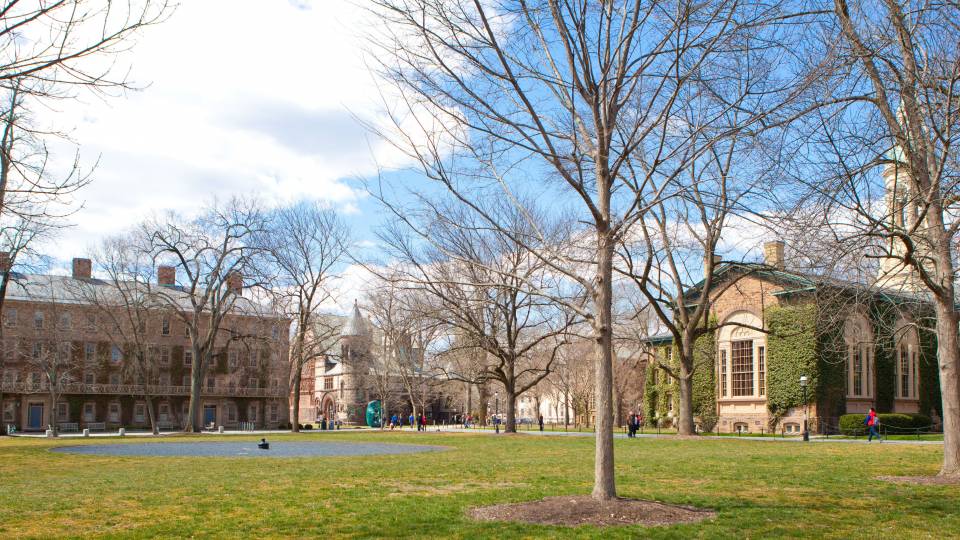Princeton University offers admission to 7.29 percent of applicants
Princeton University has offered admission to 1,931 students, or 7.29 percent of the near-record 26,498 applicants for the Class of 2017 in what is expected to be the most selective admission process in the University's history. This compares with Princeton's admission rate of a record-low 7.86 percent last year. The class size is expected to be 1,290 students for the Class of 2017.
The University's undergraduate admission office has mailed letters to students in the regular-decision applicant pool, and students will be able to see their decisions via secure online access starting today at 5 p.m. EDT. Of the 1,931 students selected for admission, 697 are students who applied through single-choice early action and were offered admission in December.
"We have admitted students who have distinguished themselves with outstanding academic accomplishments and impressive experiences outside the classroom," Dean of Admission Janet Lavin Rapelye said. "Their talents, personal qualities, intellectual achievements and experiences in the arts, athletics and activities in their communities and beyond have prepared them to join the exceptional learning community at Princeton. We are delighted to have the opportunity to welcome such promising students."
This year's applicant pool is among the largest in the University's history. During the past nine years, Princeton has seen a 93.5 percent increase in applications.
"The applicant pool was broad and deep, and selecting the students who applied for this incoming class at Princeton University was a truly difficult task," Rapelye said.
The University's generous aid program will allow prospective students the opportunity to attend Princeton who may not be able to afford it otherwise. All students on financial aid are offered grants that do not have to be repaid — giving students the chance to graduate debt free. The University's admission process is need-blind for both domestic and international students, which means that students are not at any disadvantage if they need financial aid.
Sixty percent of the current student body receives financial aid, compared with 38 percent in the Class of 2001, the last class to enroll before enhancements to Princeton's aid program. Currently, the average grant is $37,600, and for the coming year it is expected to be in excess of $39,000.
Of the applicants, 10,629 had a 4.0 grade point average, and 13,802 had scores of 2100 or higher on the three sections of the SAT. Among the high schools that rank their students, 97 percent of the admitted applicants are in the top 10 percent of their class. The pool included more than 8,750 high schools from more than 140 countries around the world.
Students receiving offers of admission to the Class of 2017 come from 47 states, plus Washington, D.C., and Puerto Rico, with the largest representation from California, followed in order by New Jersey, New York, Maryland, Pennsylvania and Texas. International students represent 11.4 percent of the admitted students and are citizens of 62 countries, including Brazil, Canada, China, Egypt, India, Israel, Korea, Mexico, New Zealand, Norway, Tanzania, Vietnam and the United Kingdom.
Of the students offered admission, 50.2 percent are men and 49.8 percent are women; 48.8 percent have self-identified as people of color, including biracial and multiracial students. Sixty-one percent of the admitted students come from public schools, and 13.9 percent will be the first in their families to attend college. Sons or daughters of Princeton alumni account for 9.7 percent of the admitted students. Of those offered admission, 23.4 percent indicated they want to study engineering, and a record 47.5 percent of those students are women.
In addition to the 1,931 students offered admission to the Class of 2017, 1,395 candidates were offered positions on the wait list. Students on the wait list who may be offered admission in May or June would receive the same financial aid considerations as students offered admission this week.
The University witnessed an 11 percent increase in early action applications. This was the second year since 2006 that the University offered an early application round for prospective students whose first college choice was Princeton. The program requires applicants to apply early only to Princeton, and allows them until May to decide whether to accept Princeton's offer.
Up to 35 members of the new class are expected to defer their enrollment for a year to participate in Princeton's Bridge Year Program. The University-sponsored program allows incoming freshmen to spend a tuition-free year engaging in international service work abroad in China, India, Peru, Senegal and a new program in Brazil. Applications for the Bridge Year Program will be due in May from students who accept the University's offer of admission.
Admitted candidates have until May 1 to accept Princeton's offer of admission.
